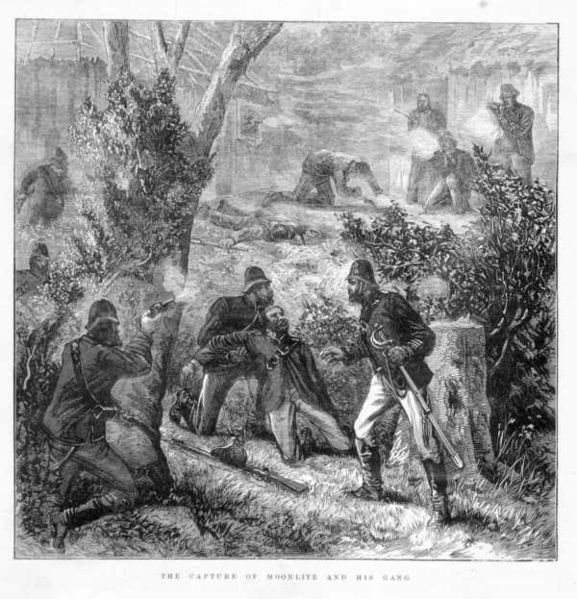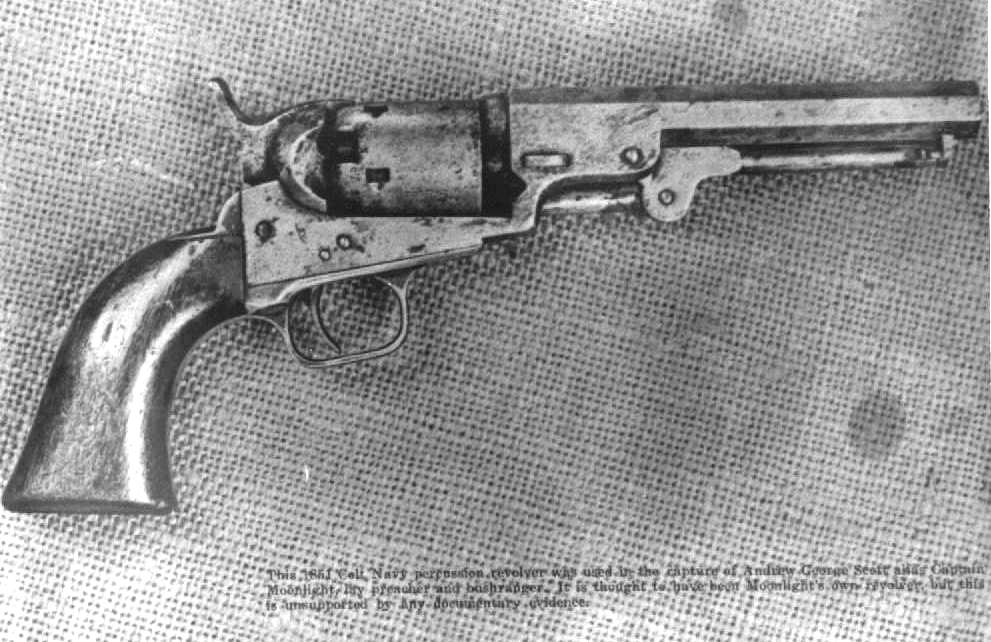The History of Blackwood – Captain Moonlight – George Andrew Scott, (1842 – 1880)
By Margot Hitchcock, Historian for the Blackwood & District Historical Society. ©
 Photo of Captain Moonlight. courtesy of Margot Hitchcock and the B.D.H.S. ©
Photo of Captain Moonlight. courtesy of Margot Hitchcock and the B.D.H.S. ©
Local legend by some old-timers of Blackwood told the folk-lore story of how Captain Moonlight (Moonlite) was a Lay Preacher in the Blackwood to Bacchus Marsh circuit and preached at All Saints Church of England in Blackwood and that he was said to have robbed the rich to help pay for the building of the half-church in Greendale, south of Blackwood, but no proof of this story was found in research. But George Andrew Scott, was said to have stayed on occasions in the Blackwood area when he preached in the local Church of England. He was also said to have stayed in a hut in Greenhills, Blackwood on a farmer’s property and some of his belongings and a gun were found under the floorboards.
Moonlight Gully on a walk near Shaws Lake Blackwood, was said to be named after Captain Moonlight.

Half -church in Greendale said to have had connection with Captain Moonlight. (Photo by Margot Hitchcock 2008) ©

Sign at Mineral springs that says – LOOKOUT & LAKE VIA – MOONLIGHT GULLY. (courtesy Margot Hitchcock 2004.) ©
Captain Moonlight – George Andrew Scott never preached at Greendale as he had left the parish and had robbed the Egerton bank in 1869 before tenders were called for in 1874 and by the time the church opened in 1877 Moonlight was in H.M. Prison Pentridge serving a sentence on a charge of stealing gold from the bank in Egerton.’
A lady told the author her late husband had been a minister at the Anglican church in Bacchus Marsh and that Andrew George Scott had signed a book there as a Lay Preacher.
(Found on the Internet from Wikipedia, the Free Encyclopaedia) – Andrew George Scott (1842 – 1880), known as Captain Moonlight or Captain Moonlite, was an Australian bushranger. Scott was born in Ireland, son of an Anglican clergyman. His father’s intention was that he join the priesthood, but Scott instead trained to be an Engineer, completing his studies in London.
The family moved to New Zealand in 1861, with Scott intending to try his luck in the Otago goldfields. However, the Maori Wars intervened and Scott signed up again, this time as an officer, and fought at the battle of Oraku where he was wounded in both legs. After a long convalescence Scott was accused of malingering and court-martialled. Scott gave his disquiet at the slaughter of women and children during the siege as the source of his objection to returning to service.
Scott then travelled to California, once more with the intention of trying his luck in the goldfields, but was again diverted from this plan when he decided to join the Union Army and fight in the already raging American Civil War. Fighting under General Sherman Scott served until the end of hostilities in 1865. Returning to civilian life he worked as a consultant civil engineer in San Francisco before moving to Australia in early 1868.
In Melbourne in1868 Scott met Bishop Charles Perry and became lay reader at Bacchus Marsh, Victoria with the intention of entering the Anglican priesthood on the completion of his service. He was then sent to the gold mining town of Edgerton.
On 8 May 1869 Scott was accused of disguising himself and forcing bank agent, Ludwig Julius Wilhelm Bruun, a young man whom he had befriended, to open the safe. Bruun described being robbed by a fantastic masked figure who signed a note absolving him of any role in the crime. The note was signed ‘Moonlite’.
Bruun claimed the man sounded like Scott but no gold was found in Scott’s possession. Scott in turn accused Bruun and local school teacher James Simpson of the crime who then became the principal suspects in the minds of police. Scott left for Sydney soon afterwards.
It was alleged that for several months, Scott lived off the money stolen from the bank. Near the end of 1870, he began to pass worthless cheques and was arrested while trying to leave for Fiji aboard a fraudulently obtained yacht. He was sentenced to 12 months in Maitland jail. In 1872 he was charged with stealing the gold at Egerton; he escaped whilst on remand for a short time before his recapture. He appeared before judge Sir Redmond Barry on 24 July 1872 and received a sentence of eleven years jail. Despite some evidence against him Scott claimed innocence in this matter until his dying day.
Scott was released from HM Prison Pentridge in March 1879. On regaining freedom, Scott met up with James Nesbitt, a young man whom he had met in prison – considered by many to be Scott’s lover, and trading on his tabloid celebrity as “Captain Moonlight” began a career as a public speaker on prison reform.
However this reputation came back to bite him and throughout this period Scott was harried by the authorities and by the tabloid press who attempted to link him to numerous crimes in the colony and printed fantastic rumours about supposed plots he had underway.
At some time during this period Scott seems to have decided to live up to this legend and assembled a gang of young men, with Nesbitt as his second in command and the others being Thomas Rogan (21), Thomas Williams (19), Gus Wreneckie (19) and Graham Bennet (18). Scott met these young men through his lecture tours or through brothels.
Scott and his gang left Melbourne in the later part of 1879, and travelling north crossed into New South Wales. While travelling through the Kelly’s area of operation, the gang were frequently mistaken for the Kelly’s and took advantage of this to receive food and to seize guns and ammunition from homesteads.
Scott’s gang bailed up the Wantabadgery Station near Wagga in November of 1879 after being refused work, terrorising staff and the family of Claude McDonald- a wealthy squatter. Scott also robbed the Australian Arms Hotel of a large quantity of alcohol and took prisoner, the residents of some other neighbouring properties- bringing the number of prisoners to 36 in total. One man, Ruskin, escaped in an attempt to warn others, but was caught and subject to a mock trial-by jury of his fellow prisoners finding him ‘Not Guilty’. Another station-hand attempted to rush Scott but was overpowered.

The capture on Moonlite and his gang. (Courtesy Wikipedia Encyclopedia.) Photo of Captain Moonlight. courtesy of Margot Hitchcock and the B.D.H.S. ©
A small party of four troopers eventually arrived, but Scott’s well armed gang held them down with gunfire for several hours until they retreated to gather reinforcements- at which point the gang slipped out.
The gang then holed up in the farmhouse of Edmund McGlede until surrounded by a much more substantial police force. During the following shootout, Senior Constable Webb-Bowen was shot and killed, as was Wreneckie. Nesbitt also died, attempting to lead police away from the house so that Scott could escape. When Scott saw Nesbitt shot down and was distracted, McGlede took the opportunity to disarm the gang leader and with the other members wounded or captured on attempting to flee, the fight came to a close.

Written above – ‘This 1851 Colt Navy percussion revolver was used in the capture of Andrew George Scot alias Captain Moonlight, lay preacher and bushranger. It is thought to have been Moonlight’s own revolver bu this is unsupported by any documentatary evidence. Photo of Captain Moonlight. courtesy of Margot Hitchcock and the B.D.H.S. ©
During the trial Scott allowed his young confederates to put all the blame on him, with them claiming to have been deceived as to the nature of their expedition, but both Scott and Rogan were given death sentences.
Scott was hanged in Sydney on 20 January 1880. Scott went to the gallows wearing a ring woven from a lock of Nesbitt’s hair on his finger and his final request was to be buried in the same grave as his constant companion, “My dying wish is to be buried beside my beloved James Nesbitt, the man with whom I was united by every tie which could bind human friendship, we were one in hopes, in heart and soul and this unity lasted until he died in my arms.” His request was not granted by the authorities of the time, but his remains were exhumed from Rookwood Cemetery and reinterred at Gundagai next to Nesbitt’s grave in January 1995. ©

Headstone of Captain Moonlight (Moonlite) in at Gundagai cemetery. (Courtesy Wikipedia Encyclopedia.) Photo of Captain Moonlight. courtesy of Margot Hitchcock and the B.D.H.S. ©
References – other information found at – Gundagai. Walkabout: Australian Travel Guide. Fairfax Digital. Scott, Andrew George (Captain Moonlite) (1842 – 1880). Australian Dictionary of Biography, Volume 6 pp 94 –95. Australian National University and Melbourne University Press (1976). Andrew George Scott (alias “Captain Moonlite”). Australian Bushrangers. Ned Kelly’s World (1999).
Researched by Margot Hitchcock from her forthcoming book ‘The History and Pioneers of Blackwood’, hopefully to be published soon. Other books published by Margot Hitchcock – “Aspects of Early Blackwood”, Some History of Simmons Reef, Blackwood” and “The Billy Pincombe Tragedy”. See – www.blackwoodpublishing.com
For help with information on Blackwood ancestors contact Margot Hitchcock – email – margothitchcock@bigpond.com




